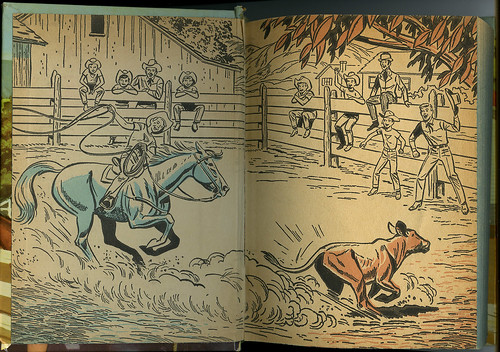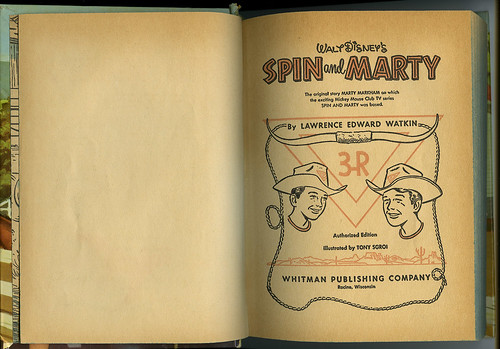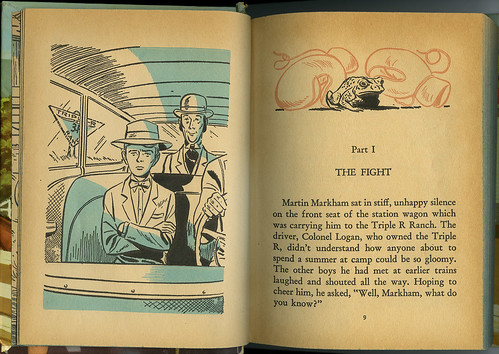This is a repost from January 12, 2012 because of the following comment I received. I thought paper doll collectors might find this interesting.
I just discovered this site, so a belated answer to those who wonder if this is the same Samuel Lowe from the Golden Books and Lowe paper doll books. Yes, my father wrote many of the books for the authors who had written for Whitman Publishing before it became part of Golden Books and was also creator of the classic doll cut-out books. —Richard Lowe
................................................
This vintage children’s book was bought a couple years ago at an estate sale. What remains memorable is that there was a beautiful bookcase in the living room with many children’s books inside; such a rare thing to find at an estate sale. If there are children’s books they’re usually reprints or books from the last 20 years and pretty low end.




Click on any image to see it larger.
This book, The Camp Fire Girls Duty Call (1916), is from The Camp Fire Girls series written between 1912 and the 1930s. Though the author says Helen Hart a little net digging shows that this was just a pseudonym for Samuel E. Lowe (1890-1952). According to Wikipedia he wrote a total of 5 books in the series as Hart. You can find this information here. I'm not finding biographical information about Lowe, but he did write several other books including The Court of King Arthur.
If you look around online you'll find Samuel E. Lowe & Co. listed for a lot of comic books. I also found a reference for Lowe working for Western Printing and Lithographing Company. Whitman, publisher of this book, was a subsidiary of Western.
There is a college scholarship, Samuel E. Lowe Scholarship, established by Western. Same Lowe? I'm guessing so. I just can't find any definitive biography of this man. Perhaps someone will find this post and fill in some details.
As to information about the series, it’s spotty at best. I did find the following information at the University of Minnesota Libraries “Girls Series Books: A Checklist of Titles Published 1840-1991” list:
The illustrator was Violet Idelle (Moore) Higgins (1886-1967) who attended the Art Institute of Chicago in the early 1900s. She illustrated children’s books, magazines, and even a weekly comic, Drowsy Dick. Click here to read a biography of Violet and her husband, Edward Roberts Higgins, also an artist.
You can click here to see more information about her methods and media.
Here and here are a few more of Higgins illustrations.
And let’s hear it for series books for girls. I remember when the San Francisco library was refusing to carry Nancy Drew books because they felt they weren’t literary enough. Balderdash! They were missing out on what girls series books have done for girls over the years. They were never meant to be literary. They were meant to give girls a different perspective as to what was possible. Yes, the stories were formula writing, but there was a comfort in seeing a girl triumph each time she set out to do something. Girls were able to see themselves in the world beyond the narrow path set for them by others. Not all series were created the same and I can’t say if the Camp Fire series challenged girls to think outside the box (an expression that should be boxed and put on the shelf), but if it helped girls feel good about themselves then it succeeded.
As to information about the series, it’s spotty at best. I did find the following information at the University of Minnesota Libraries “Girls Series Books: A Checklist of Titles Published 1840-1991” list:
Note: Publication information on this series is still a puzzle. Many of the volumes have no copyright or publication date listed. Girls Series Companion 1990 notes that chapters from volumes 2, 4, and 5 also appear in three of the MARY LEE books. (Mary Lee is also a character in the Camp Fire Girls series.) The NUC attributes volumes 5 and 7 to Samuel Edward Lowe under the pseudonym Helen Hart, and it is possible that others in the series are his work. The NUC attributes another book published by Whitman, Marigold's Pony (not part of the series), to Lowe under the pseudonym Howard B. Famous, but copies of Marigold's Pony have been seen with Rietz listed as author on the cover and Hart as author on the title page.
If you read enough of the notes at this site you’ll see why trying to pin down this series is so confusing. That said, let’s enjoy it for what it is. A book of a time period long gone.
The illustrator was Violet Idelle (Moore) Higgins (1886-1967) who attended the Art Institute of Chicago in the early 1900s. She illustrated children’s books, magazines, and even a weekly comic, Drowsy Dick. Click here to read a biography of Violet and her husband, Edward Roberts Higgins, also an artist.
You can click here to see more information about her methods and media.
Here and here are a few more of Higgins illustrations.
And let’s hear it for series books for girls. I remember when the San Francisco library was refusing to carry Nancy Drew books because they felt they weren’t literary enough. Balderdash! They were missing out on what girls series books have done for girls over the years. They were never meant to be literary. They were meant to give girls a different perspective as to what was possible. Yes, the stories were formula writing, but there was a comfort in seeing a girl triumph each time she set out to do something. Girls were able to see themselves in the world beyond the narrow path set for them by others. Not all series were created the same and I can’t say if the Camp Fire series challenged girls to think outside the box (an expression that should be boxed and put on the shelf), but if it helped girls feel good about themselves then it succeeded.

















